Common Symptoms and Their Treatments
WEIGHT LOSS AND/OR ABNORMAL FECES
There are several explanations for why a fish will lose weight. This weight loss can be accompanied by abnormal feces or unspecific symptoms like darker colors. Usually, this will be the first symptom that you will notice
If you notice that a fish who appears healthy is producing long, stringy and whitish feces, this can be an indication that your fish is infested with Hexamita, Spironucleus, or other flagellates.
Either one of these conditions can be an indication that there are gastrointestinal problems. The following tables give you an idea of possible symptoms and their causes.
| Weight Loss Symptoms (No Infection) | Cause |
| Poor appetite due to external causes |
Competition from more dominant fish. New
environment. Inappropriate/poor food
|
|
Inappropriate chemical/physical water
parameters
|
Temperature, pH, ammonia, nitrites, nitrates,
toxic compounds, low dissolved oxygen
|
| Other chronic/acute diseases | Cancers, genetic defects and malformations |
External causes and poor water conditions can be easily addressed. These causes usually stress the fish, so if you adjust their environment, you should be able to make your fish happy again. Things you can do to correct these problems include rearranging your aquarium decorations to give your fish places to hide, making sure weaker fish get enough food by feeding them specifically, performing several water changes, and ensuring your water chemistry is correct.
In regards to your water chemistry you will want to check the basics like temperature, pH, ammonia, nitrites, and nitrates, but you will also want to double check for unexpected occurrences like a malfunctioning heater or a change in your tap water’s chemical properties.
You will also want to consider the fish that share the tank with your discus. If there are fish that are trying to take a more dominant role, you may want to remove them from the tank.
Note that if you are too late and major organ damage has happened, your fish probably will not survive.
| Weight Loss Symptoms (Infection) | Cause |
| Flagellates |
Unicellular parasites with one or more
“filaments” (flagella). Often associated with
whitish and stringy feces.
|
| Tapeworms (Cestodes) | Large intestinal worms. |
|
Nematodes (roundworms, pinworms,
threadworms)
|
Round worms ranging from microscopic size
to several millimeters long. Capillaria is one
type.
|
| Other intestinal infections |
Bacteria (including fish tuberculosis), viruses,
other parasites.
|
|
Skin and Gill parasites (Flukes, Ciliates,
Dinoflagellates)
|
Parasites rob nutrients from the and the fish
stops eating in the late stages of the disease
|
These organisms that can attack your fish have a complex life cycle. They usually come from eggs or cysts that can not be easily treated with medication. Even if adult parasites are killed with an antibiotic treatment, once the eggs or cysts open, there are more parasites that may be more resistant to your medication. Because of this, over medication can sometimes be a problem because you have to repeat the treatment cycle several times to make sure all the organisms are dead.
If you do find that your fish have parasites, you need to start treatment quickly and be aggressive in getting rid of these pathogens and breaking their life cycles. You not only want to cure any fish already infected, but make sure the parasites do not get passed on to the rest of your fish if they have not already been infected.
If you find that one fish has a parasite, it is a good bet that your other fish do as well, even if they are not showing symptoms yet.
To treat your fish for parasites you will want to first treat for flagellates using metronidazole. A week after that, you will want to go after other common parasites that are not treated by metronidazole. For these treatments you can use Fluke-Tabs, Flubendazole, and Praziquantel (Droncit). Note that Praziquante is only available in the US with a veterinarian’s prescription.
These treatments will not help a fish that has stopped eating because of skin infestations by ciliates or flagellates like Oodinium. See the Abnormal Breathing Pattern section for more information on treating Oodinium.
If the treatments listed above do not work, you can try a temperature increase to get rid of protozoan infections that are on the skin and gills. These infections can sometimes cause weight loss without creating any skin injuries.
Keep in mind that your fish may have more than one parasite in its system. If you are not sure if your fish has one or more parasites, the best course is to choose a drug that will cover flukes, tapeworms, and nematodes.
EYE WOUNDS
| Common Eye Wound Symptoms | Cause |
| Wounds, scratches with or without infection |
Aggressive tank mates, sudden escape
movements, sharp objects, shipping.
|
| Popeye |
Chronic incurable diseases or poor water
conditions. Sometimes due to a bacterial
infection which can be treated with a broadspectrum
antibiotic.
|
| Cloudiness |
Aging, trauma, infections, poor water
conditions.
|
| Blisters/Cysts | Congenital or infective causes. |
Discus with Cloudiness in Eye
With your discus you will mostly see minor eye problems such as superficial scratches. However, these smaller wounds could become infected, making them a little more serious, but certainly treatable. You will know you have a problem with your see an opaque, partially or completely off-white cotton-like growth covering the eye.
If you see that one or more of your fish has this problem, you will want to first understand how the problem occurred so you can make sure it doesn’t happen again. Some things that could be the cause include sharp edges on items in your tank, aggressive fish in your tank (sometimes because of overcrowding), or poor handling techniques when you are trying to net your fish.
Because an attack from another fish is the main cause of these problems, you should reevaluate your tank density. You also want to make sure all your fish have plenty of space, as well as, shelter in your tank. You might decide that you need to remove some of the fish from your tank.
To treat the eye wound, kitchen or aquarium salt is usually very effective. You should only consider using antibiotics if the salt treatment does not work.
FIN WOUNDS
| Fin Abnormality Symptoms | Cause |
| Fin Rot |
Often initiated by a physical cause or poor
water quality, which can allow an infection.
White patches may be present.
|
| White dots | Infection due to parasitic unicellular organisms |
| Fin clamping/shaking | Possible early sign of stress or disease. |
As with many problems your discus can have, fin rot is usually due to poor water quality, physical damage that occurred during transporting your fish, and fights with other fish. When a fin gets hurt, fungi and bacteria can infect the wound. This will produce a whitish edge around the wound.
As with other problems, the treatment for this condition can be quite simple. First, you want to make sure the primary cause is removed. While many books will tell you to use antibiotics, you can try using salt first to see if that clears up the problem. Salt can get rid of the problem as well as help regrow any lost tissue. If the salt does not work, then you will have to move to an antibiotic.
Ciliated or flagellated protozoans can also cause white spots on the fins.
Fin clamping is usually a sign of stress in your fish. Because it is a very unspecific symptom, you need to watch your fish for other symptoms to help you determine the exact cause. For example, this behavior could be an indication of skin parasites, but there could be internal problems.
If fin clamping is persistent and you see other unspecific symptoms like darkening of the skin, you may have a real problem on your hands. You need to continue searching for the root cause of the problem so that you can find the right treatment for your fish.
ABNORMAL BREATHING PATTERN
Respiratory problems in your fish can be very obvious like when they gasp for air at the water’s surface; or if only one gill is working while the other ones remains closed for a long period of time, which can indicate that the gill tissue is swollen.
Sometimes, though, symptoms of respiratory problems can be very subtle only showing a slowed or increased gill movement and the problem might only occur on one side of the fish.
Sometimes fish, like humans, will breath quickly for a period of time, usually during feeding, fights, or other times of excitement. So before you become too concerned, watch your fish to see if this breathing pattern exists for longer period of time. If your fish are having breathing problems over a longer period of time you might have a water quality problem or there could be a disease at fault.
|
Breathing Abnormality Symptoms (No
Infection)
|
Cause |
| Low Oxygen |
Poor water surface movement, an excess of
organic matter (food, waste), bacterial bloom,
overstocked tank, filter failure.
|
| Ammonia |
Inadequate biologic filtration, chloramine in
the tap water, filter failure.
|
| Miscellaneous |
pH crash, chlorine, certain medications, other
toxic substances.
|
If you are noticing that your fish are having problems breathing, you should check non-infection causes first. Again, water quality if very important here. Try the following to see if they will help improve your fish’s breathing ability:
- Perform a water change of at least 50% of the tank water. You will want to do this frequently, maybe even several times a day. Keep in mind, though, that if the problem is actually with your tap water, this will not help! Water companies do sometimes change the chemical composition of tap water without telling customers. Continue the water changes until the symptoms are gone.
- There are neutralizers and filter materials that can be used to inactivate toxic substances. These are not a substitute for the water changes, but they can be used in conjunction with those changes.
- If you think the problem is because of too much ammonia in your water, you need to make sure your pH level is kept below 7. This week keep too much toxic ammonium from being created. However, don’t go below a pH level of 6 because this could damage your biological filtration.
- You also need to check your oxygen levels. You should know what your levels are normally and an oxygen test kit will be able to tell you that. You should take regular readings so you will know if a moderate drop has occurred. A moderate drop in oxygen may cause problems for your fish, but they might not show any symptoms. If your oxygen level is around 2 – 3 mg/l, your fish will most likely have major breathing problems. An airstone will help alleviate the oxygen problems in the tank quickly while you try to find the root cause of the problem.
If your adult discus has gill flukes, there will most likely be no symptoms. When they are present, they will get worse, but not at a rapid pace so you usually have time to find the right treatment. For baby discus, however, this is not the case and they could die very quickly, even if there are no symptoms.
Egg-laying flukes are the most common causes of gill infections in discus. If you have a new infection in your fish, you should assume that these flukes are the problem. The following lists treatments that are available to you, but you only want to choose one of these treatments and they are listed with the preferred method first.
- Praziquantel
- Flubendazole
- Fluke-Tabs
Correct treatment should clear up the symptoms fairly easily. However, if your tank has a substrate, you may find it difficult to get rid of the infection because the mulm may prevent the parasite eggs from the medication. You might need several rounds of treatments to take care of these pests.
If the treatment for flukes does not work or if other symptoms like white dots on the skin or fin are present, your fish might have a ciliate or flagellate infection. If this is the case, you can try raising the temperature of the tank. Keep in mind, though, that if there are other types of fish in your tank, they might not handle the temperature increase very well. In that case, you should do some more digging to make sure that is the problem that needs to be addressed and then check a good fish health book for an alternative treatment.
If your situation is critical and you have to act fast, but you’re still not exactly sure what the problem is, you can use two or three doses of formalin+malachite green. This should give your fish some temporary relief while you track down the root cause of the infection and treat it.
SKIN WOUNDS
Skin Wounds Regular observation of your fish is a good way to monitor your fish’s health. You will most often see minor scratches and, once in a while, missing scales that are usually due to discus fish showing dominant behavior. These minor things will be gone in a few days. There are some skin changes, however, that might be signs of healthy problems. These changes include:
- Persistent dark color
- Discolored patches
- Whitish dots
- Increased skin mucus
- Bumps, sores, open wounds
- Raised scales
| Skin Abnormality Symptoms (No Infection | Cause |
|
Dark color, increased skin mucus, infected
skin patches, frayed fins, abnormal swimming, rapid breathing.
|
Low pH (approximately below 4.5) |
| With or without signs of infection. | Wounds |
| Bumps, possibly ulcerated. | Skin or deep tissue cancers |
|
Possibly associated with intestinal parasites,
but primarily due to deficient nutrition.
|
Hole in the Head |
As with so many discus fish ailments, water quality is your main defense and treatment for skin problems. If your fish is showing some skin problems, first try treating it with some salt, which should help speed up healing. You can also try a water disinfectant like methylene blue if you don’t want to use the salt.
You do NOT want to use antibiotics at this time. They are probably not needed and they may cause more harm if they negatively affect your biological filtration system.
Once you have used salt and restored your water quality to acceptable levels, your fish’s immune system should be strong enough to heal the skin wounds. However, if the damage was severe, it might not be reversible even with water changes and antibiotics. In most cases, skin or deep tissues cancers are not treatable.
Hole in the Head (HITH) is a common problem with discus and appears to be primarily caused by a vitamin or mineral deficiency. The disease starts slowly with small holes appearing near the nostrils, on the gill plates, or near the eyes. If left untreated the holes will continue to grow in size until portions of the head are destroyed. The fish will eventually die of malnutrition and infection.
Discus with Hole in the Head
HITH can be a rare or common problem for keepers of discus fish. Some keepers never see it, while other see it regularly, even if they are feeing their fish properly! In any event, proper nutrition is one of your best defenses for this disease. Dry foods are usually not enough to prevent HITH, so you want to make sure your fish gets plenty of fresh food with vitamin supplements.
If you discus fish does get HITH, you can treat it with metronidazole , which is recommended by several books on fish care. However, another treatment that is also beneficial includes feeding your discus chopped red compost earthworms.
Treatment of your discus for HITH can result in a 100% cure rate within a few weeks of starting treatment. After your fish is healed, feeding your fish the chopped red compost earthworms once or twice a week should help prevent the disease from coming back.
There are several websites that will give you instructions on how to grow red composting worms. You can also purchase starter cultures from various sources. Check aquarium or organic gardening magazines for advertisements.
|
Skin Abnormality Symptoms (With
Infection)
|
Cause |
| Scratching against objects, dark color. | Flukes |
|
Dark color, white dots of various size and
number, increased mucus, white patches,
scratching, fin clamping, weight loss.
|
Protozoans (Flagellates and Ciliates such as
Oodinium, Ich, Costia, and Chilodonella)
|
|
Dark color, white patches, scratching, fin
clamping, lying in a corner or at the bottom.
Often seen in recently shipped juveniles.
|
Bacterial Infections |
| Large patches forming a reticular pattern. | Discus Plague |
Trying to determine the cause of skin infections can be difficult. Often times you will first notice unspecific symptoms like your fish rubbing against objects and dark skin color. If you see no other symptoms after careful observation, the problem may just be flukes. However, if you see a lot of mucus and patches or white dots, there is a good chance that a protozoan is making your fish sick.
Skin flukes usually cause infections that are slow to progress. Overcrowding can increase the chances of the infection spreading; and if the flukes are live bearing, they can be transmitted from one fish to another just by coming into contact with each other.
Skin protozoan infections move quicker than infections by skin flukes and can be caused by many different things. You should review a fish health book to understand these infections and what causes them. This type of infection can spread from fish to fish and even tank to tank if you are using infected equipment. You should definitely use separate sets of tools for each aquarium you have.
To treat skin protozoans you can use temperature increases or medications. If there are white dots on your fish’s skin or your treatment for flukes has failed, you might try a temperature increase to 93 degrees Fahrenheit. However, keep in mind that this might not be an option if you have other types of fish in your tank that cannot handle the increased temperature.
Young fish that have just been shipped and fish that just had a pH and temperature shock are more susceptible to bacterial skin infections. In these cases, you want to use a broad spectrum antibiotic like those in the furan family.
The Discus Plague is quite rare, but when it happens, it is quick. No one is sure what causes it, but it progresses rapidly, is very infectious, and usually results in the death of the fish. The most common symptom that you will see is increased skin mucus production and a reticulated pattern on the skin.
ABNORMAL SWIMMING PATTERN
You need to observe your fish and understand their swimming patterns. While certain swimming patterns can mean there is a problem with your fish, they can also be signs of nervousness. If your fish is headstanding a lot or lying flat, there is a good chance that there is a problem. Darting and hiding, however, can be quite common for healthy fish.
Before following any course of treatment, watch your fish for any dominance behavior. You may have some fish who are too aggressive in your tank and need to be removed.
The following table lists some common causes for abnormal swimming and how to treat them.
| Swimming Abnormality Symptoms | Cause |
| Headstanding, lying flat |
Water quality problems, drug side effects,
swimbladder infection, intestinal obstruction,
late stage of infectious diseases.
|
| Darting |
Water quality problems, skin parasites, drug
side effects, stray voltage in the tank.
|
| Swimming by the surface | Lack of oxygen. |
Many abnormal swimming problems can be related to problems discussed throughout this section. However, there are some other things you should investigate.
You might want to check to see if the electrical equipment around your tank is poorly insulated because it could be release stray voltage into your water. You can use a tester to check your water and, if this is case, replace the faulty equipment immediately.
Your fish might have an intestinal obstruction with bloating that can have a bad affect on the swimbladder’s functionality. This usually happens with you overfeed your fish or use dry foods that have not been previously hydrated. To fix this problem, you want to stop feeding your fish until the problem resolves. If it is not cleared up in a few days, you can add Epsom salts to your tank using two teaspoons for every ten gallons of aquarium water. This should work to clear the intestinal tract of your fish within a few days.
While swimbladder infections do happen, they are not very common. When they do occur, however, they are usually caused by bacteria. Some signs of a swimbladder infection include headstanding, lying flat, and swimming poorly.
If your fish is still not swimming properly and you have determined that your water quality is OK, and there is no intestinal obstruction, it is safe to assume your fish has a swimbladder infection.
The other problems are more common and that is why you should rule them out before starting treatment.
Swimbladder infections are sometimes caused by flagellates. You can treat this problems with metronidazole.
QUESTIONS
- What are common health ailments for discus?
- How can you keep your discus healthy?
- How can you prevent your discus from getting sick?

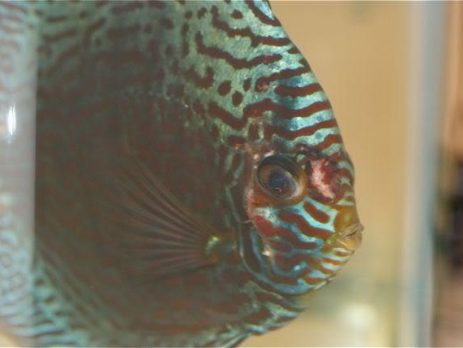
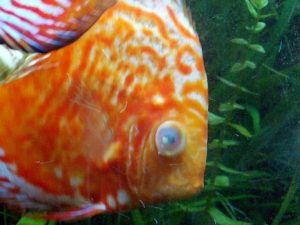
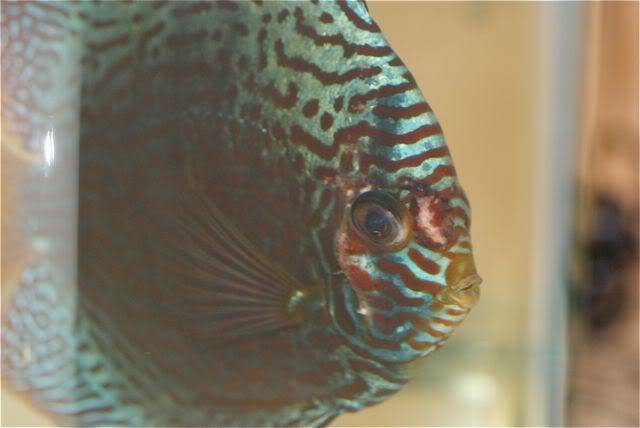


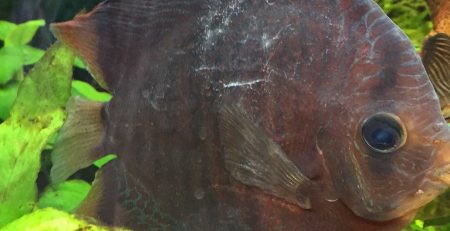


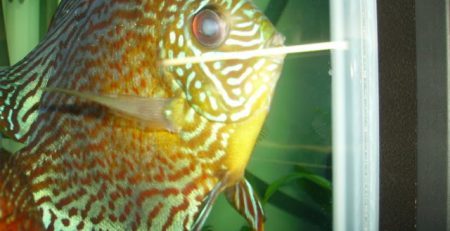
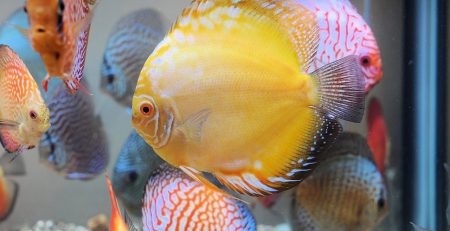

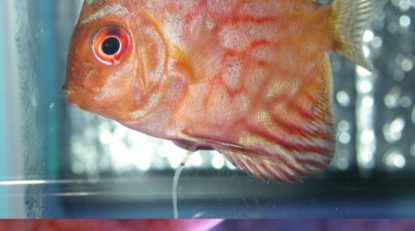
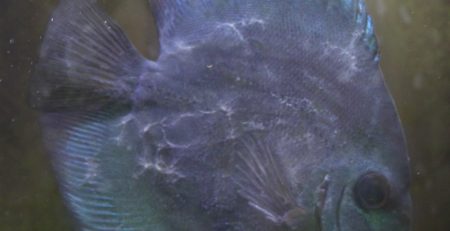
Leave a Reply
You must be logged in to post a comment.